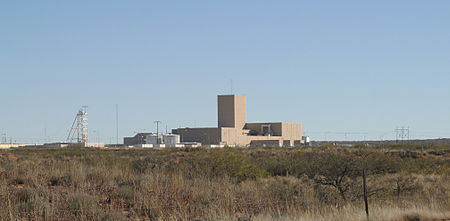I have blogged about the accident that closed the Waste Isolation Pilot Plant (WIPP) near Carlsbad, New Mexico before. The WIPP is the geological repository for nuclear waste resulting from the development and manufacture of nuclear weapons for the U.S. arsenal. The Los Alamos National Laboratory (LANL) is one of the places where such nuclear weapons are developed. They had about three hundred barrels of liquid waste that needed to be disposed of. WIPP does not accept liquid wastes so an absorbent material had to be added to the barrels before they could be shipped. Someone decided to change the absorbent from an inorganic clay compound to an organic material. Unfortunately, the new absorbent reacted with the waste in the barrels to generate hydrogen gas.
In February of 2014, one of the LANL barrels sent to the WIPP exploded and release radioactive materials. Due to a lax safety culture, the room that contained the barrel had not been sealed. The radioactive particles passed through the filter system that should have trapped them and dispersed over the countryside. The WIPP was shut down and, after a cooling off period, repairs were undertaken. The plant is still closed and it is not clear exactly when it will reopen to accept nuclear waste. Federal officials say that they hope to start limited waste processing by the end of this year but full operations cannot resume until the ventilation system is replaced. The replacement is expected to be completed by 2021.
An investigation into the accident found that there were more than two dozen failures of safety protocols at the WIPP including the failure of the filtration system. Twenty one workers at the surface facilities were exposed to low doses of radiation that officials say were well within safety limits. Critics of the response of the federal government say that federal officials have downplayed the seriousness of the accident and its aftermath.
The accident at the WIPP may be one of the costliest nuclear cleanup in U.S. history with initial estimates as high as two billion dollars. This is close to what it cost to clean up the partial meltdown at Three Mile Island that took place in 1979. The accident and closure of the WIPP is also interfering with cleanup of nuclear weapons related waste from other sites. In Washington state, the shipment of twenty four thousand barrels of waste from Hanford to WIPP has been delayed. In Idaho, two hundred thousand barrels of waste have to be sent to WIPP by 2018 from the Idaho National Laboratory.
The direct cost of the cleanup has now reached six hundred and forty million dollars. The two billion dollar cleanup cost mentioned above may be exceeded by the cost-plus contract with the contractor doing the cleanup. Additional costs may be connected to the replacement of the ventilation system. The WIPP will have to be operated longer than originally intended and this will also add to the cost of operations. The WIPP costs about two hundred million per year to operate. If it has to be kept open an additional seven years, that will be an additional one billion four hundred million dollars. There will also be expenses related to temporary storage of nuclear waste while the WIPP is closed.
Don Hancock monitors the WIPP for Southwest Research and Information Center, a watchdog group. He points out that the WIPP was supposed to be free of radioactive contamination throughout its operating life. Now the facility has been contaminated with radioactive materials, it will be more difficult to operate safely. He says that the WIPP may never resume full operations.
There were many contributing factors to the accident and shut down of the WIPP but it all started with the bad absorbent. One of the contractors working at LANL sent a memo to management saying that he was not qualified to decide whether it would be safe to change to the new absorbent but that someone with the requisite technical skills should look into the question. That never happened and now billions of dollars have to be spent because of that failure of management at LANL.
Waste Isolation Pilot Plant:
